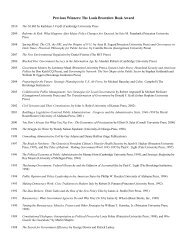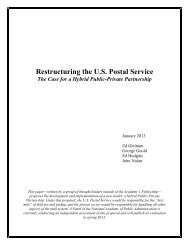High-Performance Partnerships - National Academy of Public ...
High-Performance Partnerships - National Academy of Public ...
High-Performance Partnerships - National Academy of Public ...
You also want an ePaper? Increase the reach of your titles
YUMPU automatically turns print PDFs into web optimized ePapers that Google loves.
FIGURE 10-2<br />
PHASES OF LEADERSHIP<br />
Management Skills<br />
"There's a Crisis"<br />
"Let's get moving"<br />
"We need standard<br />
operating procedures"<br />
"Check with<br />
the Customers"<br />
"Let's reorganize"<br />
"Follow Me"<br />
"Mentoring is<br />
my Job"<br />
Leadership Skills<br />
"Yeah Team!"<br />
Start Up<br />
Mid-life<br />
(Development)<br />
Mature<br />
Source: John Lesko, Facilitator<br />
ance track record and independent funding<br />
streams. During this period, it is working to<br />
stabilize its resource base, grow to scale, evaluate<br />
outcomes and processes, and increase cost<br />
effectiveness.<br />
By the time the partnership delivers its services<br />
and programs to scale, its revenue base should<br />
be more stable. It should have established a<br />
track record and be positioned to attract<br />
stronger members and more funding. Fewer<br />
resources should be invested in building relationships<br />
and an organizational infrastructure.<br />
COMMUNICATIONS<br />
A partnership initially focuses its communications<br />
strategies on building support among its<br />
members, funders, and external stakeholders.<br />
Young partnerships may have difficulty communicating<br />
their message because they may<br />
not yet be clear on mission and goals. Yet<br />
communications are critical to generate sufficient<br />
support to obtain funding and member<br />
buy-in. Communications are more intense<br />
and critical to secure lasting relationships that<br />
will be the basis for the long-term partnership.<br />
Communications channels are less formal and<br />
more focused on the need for the partnership,<br />
not results.<br />
As the partnership enters its operational/developmental<br />
phase, communications channels<br />
become more formalized and varied.<br />
Newsletters, brochures, annual reports, and<br />
other materials should be available for electronic<br />
and print distribution. In addition, the<br />
partnership can report its results. Recognizing<br />
its good work can become a major focal point<br />
when customer and stakeholder communications<br />
are established. Closing the feedback<br />
loop and acting on input are critical activities<br />
during the mid-life period.<br />
Once the partnership reaches maturity, communications<br />
channels should be very formalized,<br />
with annual reports, routine meetings <strong>of</strong><br />
the governing body, partners, and staff, and<br />
institutionalized customer feedback loops.<br />
The challenge <strong>of</strong> keeping stakeholders<br />
informed never dissipates entirely, but it<br />
should become easier once the institutional<br />
framework is in place.<br />
121 Powering the Future: <strong>High</strong>-<strong>Performance</strong> <strong>Partnerships</strong>









